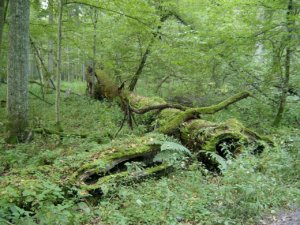
Yesterday UNESCO called on the Polish government to halt the logging of the World Heritage Site of Białowieża forest.
This is good news – but will the Polish government listen?
Most governments would be highly embarrassed to be hosting an international summit and be criticised for its actions by its guests. UNESCO’s 41st World Heritage Committee meeting is being held in Krakow, and outside the conference protestors have been demonstrating against the environmental damage encouraged by the Polish government. About 400km to the northeast, protesters were blocking entrances to the forest to protest against logging.
Poland’s environment minister, Jan Szyszko, argues that beetles pose a threat to the forest and that logging will help protect the trees. Szysko is a forester.
‘Let’s hope this fresh warning will stop the illegal logging before Europe’s oldest forest is irreversibly damaged’ said Agata Szafranska, lawyer at ClientEarth.
Today President trump is visiting Poland – maybe he’s going to buy timber?
[registration_form]
Is there a protest in London this Saturday about this matter? Can anyone say as I have seen nothing ion social media?
There is a demo this saturday, 11am Eros, Picadilly…. its on facebook here : https://www.facebook.com/events/218567288653938/ ……two of my friends in Cambridgeshire who have never been on a demo are going, such is their feeling about this (Unfortunately I cannot join them as I am working)
Seeking some clarification here please.
I went to Bialowieza in the late 90s, and it is a fabulous place. However it’s certainly not virgin forest. I spent a week there, mostly on my own, wandering the forest looking for bison. The closest I got was a steaming pile of fresh dung but I still saw a lot of other wildlife and had an inspiring time.
There is a “restricted reserve” (or something like that) where you weren’t allowed to go without a guide. This was probably as close to virgin forest as you’ll find in lowland Europe, and even though there are still some visible signs of past management it was mostly light touch stuff – honey collecting, that sort of thing. It had been subject to a little timber management back in the 19th century and earlier, but on a small and intermittent scale, so it looks and feels uniquely primeval even if you know intellectually that it’s isn’t truly virgin wilderness. Logging here would be a crime and a tragedy. This closed reserve is however a very small part of the forest.
Surrounding that was a huge area of more or less recently managed woodland, in blocks with linear rides on a grid system. Each block was a 100m x 100m square, though some had coalesced with time. Some were young growth, clearly having been logged during the communist period post-war, others were older but still with a definite “crop” feel to them, and then there were others that were a mix of ages of trees, probably historically managed by selective felling. There were a few that felt pretty wild on a small scale. The excellent 1:50,000 map published by the main Polish nature conservation NGO even gave the dates of when each block had last been felled – naturally I targeted the oldest ones from the 19th century, which was at most 20% of them from memory. It is all essential buffer for the closed reserve, but none of the 1 ha blocks could remotely be described as primeval. The extensive wetter areas were covered an apparently natural growth of mostly younger trees – very like our carr here. The bison, incidentally, prefer this area to the core closed reserve.; Its more open character offers more forage for them. So do deer, boar, and hence the wolves.
Logging in this wider area would not be out of keeping with management as practiced for generations. It might or might not be wise, or sensitive, or nature friendly, depending on how its done (clearfell vs selective, size of coupes, etc). I’d prefer to see large parts left alone, personally, but I don’t think that logging here would necessarily be an environmental outrage (unlike cutting anything in the closed reserve area).
Beyond that was an mosaic of high nature value farming – peasant farms with storks and farmland birds in abundance and rare arable weeds and all manner of other wildfire we lost here long ago. I suspect much of this has been abandoned since my visit– there were signs of widespread depopulation and a lack of young people even 25 years ago. In principle woodland management here would seem perfectly appropriate, even beneficial, to me (with the usual caveats about how its done, see above).
So which bit is being logged? The press coverage states the area of the wider reserve but seems to wrongly imply that it’s all like the closed area. It really isn’t – maybe 90% is much more like our UK ancient woodland, with a long and more or less continuous history of management, than it is like wilderness.
Can anyone clarify please?